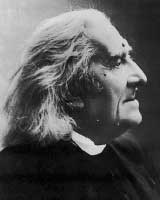Leif Ove Andsnes
March 19, 2000 Program
Claud-Achille Debussy: Estampes
Franz Liszt: Deuxième année: Italie
Johannes Brahms: Intermezzo in B flat major, Op. 117, No. 2
Franz Liszt's Années de pèlerinage (Years of Pilgrimage)
Franz Liszt (1811-1886) was known in his day for his fiery piano playing.
With his extraordinarily long hands, he could stretch over 10 keys at
a time - as one concertgoer once wrote, Liszt played the most impossible
passages "as if he had photographed them in their minutest detail
upon the ear of his listener". A Hungarian by birth and educated
in Vienna and Paris, Liszt was an international sensation by his late
teens, a reputation further enhanced by his piano transcriptions of
diabolically difficult pieces such as Herctor Berlioz's Symphonie fantastique
or Niccolò Paganini's La campanella.
| For information about Leif Ove Andsnes recordings visit Public Radio MusicSource. |
| |
 |
| |
Franz Liszt
|
Yet Liszt was not just a showman only eager to dazzle with effects; he
was deeply religious throughout his life, and there is a strong spiritual
element to many of his works, as seen in his three-volume Years of Pilgrimage.
A masterpiece of the Romantic age and a landmark in the piano repertoire,
the work traces his own spiritual and emotional journey through life.
The pieces of the first two books commemorate his sojourn in Switzerland
and Italy in 1835-39 with his mistress Marie, Countess d'Agoult - some
of his happiest years. Book I, entitled Switzerland, dates from 1836-7,
and is full of unbridled, youthful passion, while Book II, Italy, (also
from 1837), evokes a more reflective man for whom the spiritual - be it
in love or art-is the focus of life. The dark and menacing Après
une lecture du Dante - in which, Lizst writes, he aimed to capture the
"strange tongues, lamentable cries, words of pain and tones of anger"
of Dante's Divine Comedy - is from this more impressionistic second volume.
The final volume of the triptych, also entitled Italy, was written when
Liszt was 66 and reflects his pain following the death of two of his children
and the strained relationship with his daughter Cosima (mistress and later
wife of his friend Richard Wagner).
Although the pieces of both Book I and II started life as unconnected,
occasional songs evoking the beautiful surroundings of the Swiss and
Italian countryside or his own reflections on works of art, Liszt reworked
the pieces several times before publishing them as the Years of Pilgrimage
in 1855. This reworking, together with the addition of the final book,
was designed to create a unified work of universal significance - turning
his own musings on life and art into a spiritual work reflecting humanity's
struggle to escape the temporal world through art and religion. As musicologist
Phillippe Mougeot notes, "The pieces do not chart geographical
itineraries, but rather that spiritual journey which leads mortal man
towards immortality through the deeper explorations of his inner being."
The quotation from Phillippe Mougeot is from the liner
notes to Liszt: Les années de pèlerinage, performed by
Aldo Ciccolini (EMI 62640). The quotation in the first paragraph is
from Franz Liszt in The Grove Dictionary of Music.
|
